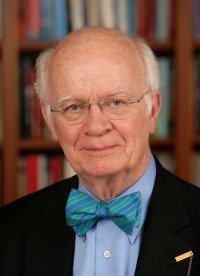Weighing in: On the horizon of a black hole
Robert Solow on his friend Milton Friedman: “One difference between Milton and myself is that everything reminds Milton of the money supply. Well, everything reminds me of sex, but I keep it out of the paper” (New York Review of Books, February 15). We keep many things out of M.E.M.O. Money? Sex? No—only war. Everything these days reminds me of the Iraq war, but I usually keep it out of the column. Everything these days suggests analogies to our 300 billion dollar—that’s 300,000 million dollar—Iraq venture.
First let’s ponder tiny matters of weight (we’ll come back to the analogies later). Discover magazine recently set out to answer the question: “How much does the Internet weigh?” One e-mail, they say, weighs “about two ten-thousandths of a quadrillionth of an ounce.” Everything being stored on the Internet, these scientists figure, means that the weight of the Internet adds up to just “about 0.2 millionths of an ounce,” or the same as “the smallest possible sand grain, one measuring just two-thousandths of an inch across.”
In the May 14 New Yorker, Elizabeth Kolbert writes about the $8 billion Large Hadron Collider at CERN (the European Organization for Nuclear Research), which will be activated in mid-2008. It may help “unlock the secrets of the universe or, barring that, prove this ambition to be hopeless.” Scientists to date have “observed” 16 pointlike or fundamental particles, fermions, quarks, hadrons, antiquarks, protons and neutrinos “which, somewhat unnervingly, stream through our bodies at the rate of trillions per second.” Next they hope to find the Higgs particle, long theorized to exist. How much would it weigh? Maybe 2 x 10-22 grams.
Let’s also talk about short times. These unstable particles do not last long. A top quark “is estimated to last no more than 1 x 10-24 seconds. To compare, 1 x 10-24 centuries comes to three-millionths of a billionth of a second.” The CERN people hope to throw new light on black holes, if they don’t get sucked in by one.
In the March Scientific American Bernard J. Carr and Steven B. Giddings explain the holes to us: “Einstein’s theory . . . predicts that if matter is sufficiently compressed, its gravity becomes so strong that it carves out a region of space from which nothing can escape. . . . Objects can fall in, but none can come out [emphasis mine].” That reminds me of the dimensions of our war.
Here are some analogies: “About 0.2 millionths of an ounce” is the weight I’d place on the credibility of the Weapons of Mass Destruction rationale for starting the war. That is also the weight of the WMDs found in Iraq.
I’d calculate the same weight as the burden most Americans feel because of the war. Being slowed down in airport screening lines is about the extent of our being inconvenienced. Unless you are near a military installation you won’t see signs of suffering. We are passing the burden of paying for this war to our grandchildren, while for us its moral weight is “about 0.2 millionths of an ounce.”
As for time: I’m willing to give the unstable Iraqi parliament the time a quark thrives, 1 x 10-24 seconds, to get its act together. And that’s how long I’d wait for our military people to end their attempts at finding a military solution to the situation we created.
Like Solow, who thinks about sex all the time but does not put it in the paper, I think about the war all the time: I believe we’re on the horizon of a spiritual and moral black hole. But I will go on for the next fortnight as if oblivious.






